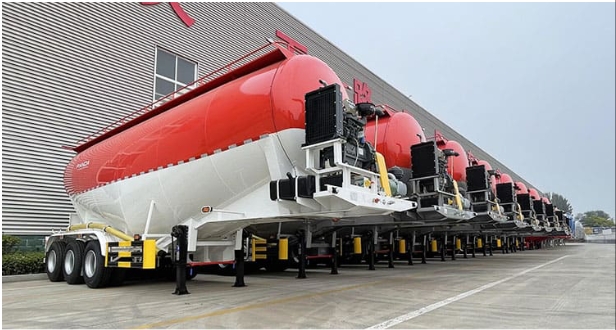
Guide of what is cement made of
Cement is one of the most important building materials used in construction. It is a fine powder that, when mixed with water, forms a paste that hardens and binds to form concrete. In this article, we will take a comprehensive look at what cement is made of, how it is manufactured, its types, uses, and its impact on the environment.
How to transport cement
We need cement bulker, cement tank trailer to transport cement.
Raw Materials
The primary raw materials used in cement manufacturing are limestone, clay, and shale. These materials are quarried, crushed, and blended in specific proportions to create a raw mix. Other materials like iron ore and fly ash may also be added to the mix.
Limestone
Limestone is the primary source of calcium oxide used in cement manufacturing. It is quarried from deposits and transported to the cement plant where it is crushed and blended with the other raw materials.
Clay
Clay is another essential ingredient in cement manufacturing. It contains aluminum oxide, iron oxide, and silica. It is quarried and crushed before being blended with the other raw materials.
Shale
Shale is a sedimentary rock that contains clay minerals. It is also an essential raw material in cement manufacturing. Shale is quarried, crushed, and blended with the other raw materials.
Iron Ore
Iron ore is added to the raw mix to provide the necessary iron oxide to make the cement clinker. It is transported to the cement plant and blended with the other raw materials.
Fly Ash
Fly ash is a waste product of coal-fired power plants. It contains silica, alumina, iron oxide, and calcium oxide. Fly ash can be used as a substitute for some of the raw materials used in cement manufacturing.
Manufacturing Process
The manufacturing process of cement can be divided into five stages: quarrying, crushing and grinding, mixing and blending, burning, and cooling and grinding.
Quarrying
The raw materials are quarried from deposits and transported to the cement plant.
Crushing and Grinding
The raw materials are crushed and ground into a fine powder. This powder is called the raw meal.
Mixing and Blending
The raw meal is blended and mixed thoroughly to create a homogeneous mix.
Burning
The raw meal is fed into a preheater and then into a kiln where it is heated to high temperatures. The heat causes the raw materials to react and form the clinker.
Cooling and Grinding
The clinker is cooled and ground into a fine powder. This powder is called cement.
Types of Cement (continued)
Rapid Hardening Cement (RHC)
Rapid hardening cement is similar to OPC but is ground to a finer powder, which makes it harden faster. It is ideal for construction projects that require a quick turnaround time.
Quick Setting Cement (QSC)
Quick setting cement is similar to RHC but contains a higher percentage of calcium chloride, which makes it harden even faster. It is often used for emergency repairs and in cold weather.
White Cement
White cement is made from raw materials that contain very low levels of iron and manganese oxide. It is used in decorative applications like tiles, terrazzo, and stucco.
Coloured Cement
Coloured cement is produced by adding pigments to the raw materials. It is used in decorative applications and can be matched to any color.
Quality Control
To ensure that the cement meets the required specifications and standards, quality control tests are carried out at every stage of the manufacturing process.
Testing of Raw Materials
The raw materials are tested for their chemical and physical properties to ensure that they meet the required specifications.
Testing of Cement
The finished product is tested for its strength, setting time, and other properties to ensure that it meets the required standards.
Uses of Cement
Cement is used in a wide range of applications in the construction industry, including the production of concrete, mortar, and grout.
Construction Industry
Cement is used to construct buildings, roads, bridges, and other infrastructure projects. It is also used in the manufacture of precast concrete products like pipes, panels, and blocks.
Concrete Production
Concrete is made by mixing cement, sand, and gravel with water. It is one of the most widely used building materials in the world.
Other Applications
Cement is also used in the manufacture of plaster, stucco, and other decorative applications.
Environmental Impact
The cement industry is one of the major contributors to greenhouse gas emissions, accounting for around 7% of global emissions.
Emissions
Cement production emits large amounts of carbon dioxide, nitrous oxide, and sulfur dioxide. These gases contribute to climate change and acid rain.
Energy Consumption
The production of cement requires large amounts of energy, which comes mainly from the burning of fossil fuels like coal and natural gas.
How to transport cement
We need cement tanker truck to transport cement.
Conclusion
In conclusion, cement is an essential building material used in construction worldwide. It is made from raw materials like limestone, clay, and shale, which are quarried, crushed, and blended to create a homogeneous mix. The manufacturing process involves several stages, including quarrying, crushing and grinding, mixing and blending, burning, and cooling and grinding. There are several types of cement available in the market, each with its unique properties and uses. Quality control tests are carried out at every stage of the manufacturing process to ensure that the cement meets the required standards. However, the production of cement has a significant impact on the environment, and steps need to be taken to reduce its carbon footprint.



